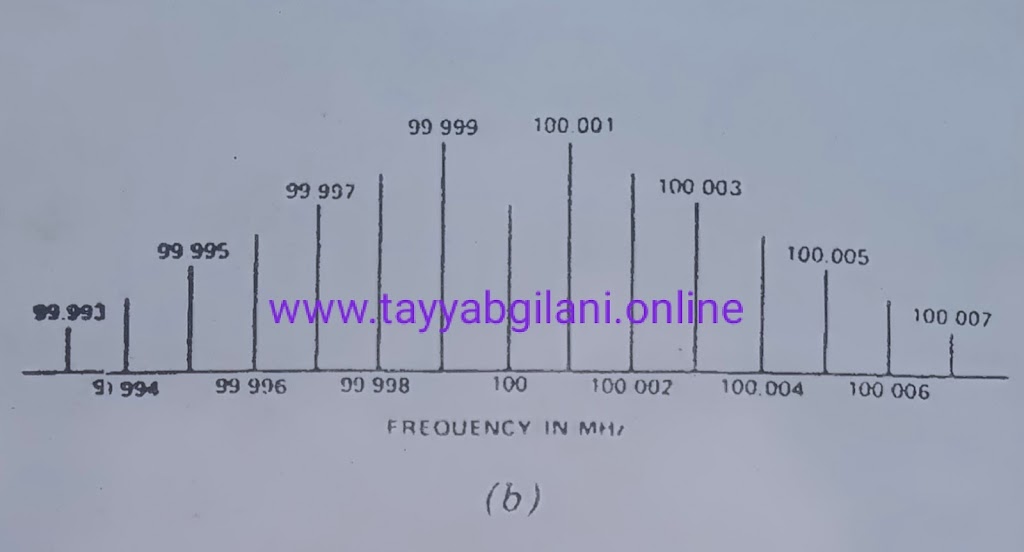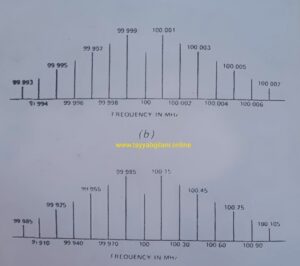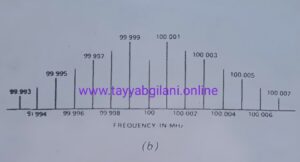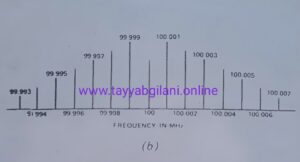 |
| Frequency MHz |
Frequency Modulation FM
FM (frequency modulation) is a method in which the frequency of a carrier signal is changed according to the information of the modulating signal. In this case, the amplitude of the signal is always constant as the frequency changes with time, which also shows changes in the modulating signal. For example, frequency modulation is used in radio broadcasting. Its main purpose is this. That high-quality audio transmission can be achieved with low noise. A special feature of frequency modulation FM is that such modulation techniques are more robust against noise and interference. Due to this, it is mostly used in music and voice communication.
How does FM (Frequency Modulation) work?
The modulation process in FM (Frequency Modulation) basically works like this.
In contrast to linear modulation, exponential modulation is nonlinear process and therefore the modulated spectrum is not related to the message spectrum in a simple fashion.
The Modulated waveform after exponential modulation can be expressed by the equation.
Xc (t) = Ac Cos (wct+¢t)+Ac Re[ej (wc.t+¢(t)]
Where
¢(t) represent the varying phase or the frequency containing the message,
Ac is the constant amplitude wc.
= 2π fc is the angular frequency of the carrier wave,
And
Re means that we take the real pan of the exponential function in brackets.
As we see, the message in inserted into the angle of the carrier wave or in the expdonent of the fashion describing a cosine wave. This is why these modulated methods are called angle or exponential modulation.
In FM, the instantaneous frequency of the carrier is varied according to the message and its amplitude is kept constant.
The Frequency Modulation, FM, is the process of combining a modulating signal with a carrier wave in such a way that the amplitude of the modulating signal causes the carrier wave to vary in frequency.
The instantaneous amplitude change of the modulating signal varies the frequency of the carrier wave. The frequency of the modulating signal controls the rate at which the frequency of the carrier changes. There are only frequency variations.
The modulating signal is shown in figure below.
Carrier Signal
First a carrier signal is generated. The frequency of which is constant.
Modulating signal
These signals contain information or data. Audio signal etc.
Change in frequency
The frequency Modulation of the carrier signal is also changed based on the amplitude of the modulating signal. So that if the amplitude of the modulating signal increases, then frequency of the carrier signal also increases.
Same as, if the amplitude of the modulating signal decreases, the frequency of the carrier signal also decreases.
Modulated signal:
As a result, the information from this modulating signal can be transmitted by changes in the carrier frequency. A practical explanation of FM modulation is as follows:
Radio Broadcasting:
Radio broadcasting consists of a carrier signal at a specific frequency (e.g., 100.1 MHz). Whenever you listen to music, So in this case, the audio signal (modulating signal) changes the frequency of the carrier signal. Such changes are demodulated from the carrier signal in the receiver, and the audio signals are then recovered.
Uses of FM (frequency modulation)
The frequency modulation has various uses in various fields due to its high quality and robustness against noise. Some of these important uses are as follows:
FM radio broadcasting is most commonly used for the transmission of audio signals.
FM radios operate in the 88–108 MHz band. They provide the highest-quality and clear sound. They are used mainly for music.
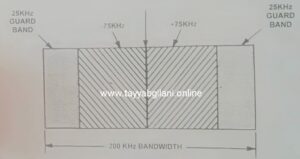 |
| RF Carrier Center Frequency |
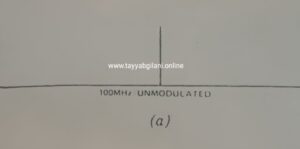 |
| 100MHz. Unmodulated |
The energy contained in each sideband pair two sideband’s spaced equally above and below the carrier center frequency decreases as the sideband pairs remove from the center frequency. A point reache where a sideband pair contains so little energy that they can disregarded.
Modulation Index
This point determined using a modulating index. The modulation index is a ratio of RF carrier frequency deviation to the modulating AF signal frequency.
Television Broadcasting Audio Transmission
In TV broadcasting, the audio signal modulated FM. So that the audio signal along with the video sent with high quality and minimum noise.
Wireless communication:
Personal Mobile Radio (PMR):
FM modulation also used in wireless communication systems. For example, walkie-talkies, handheld radios, etc.
Aviation Communication
FM modulation also used in the aviation industry. To enable clear and noiseless communication between pilots and control towers.
Data Communication Telemetry:
Telemetry systems also use FM modulation to easily transmit sensor data and other types of information wirelessly. Which includes space missions, etc.
Modem
FM modems also used for data transmission where digital data can easily converted to analog signals.
Medical field
FM Herring Aids:
Hearing aids also use FM modulation to help users hear clear and distinct sounds, especially when they are in classrooms or noisy environments.
Science and Research and Radar Systems
FM modulation also used in radar systems to detect distant objects.
Spectroscopy
FM modulation used in various scientific experiments and instruments to make more accurate measurements.
These diverse uses of FM modulation make it of central importance in various fields due to its efficiency, quality, and resistance to noise.
Better sound quality:
In FM modulation, the frequency of the signal changed. Due to this, noise and interference reduced. As a result, the sound quality has greatly improved. This type of technique is especially useful for music and speech.
Noise Resistance:
FM signals are highly resistant to noise and interference. These signals produce much less noise than AM. Due to this, the definition of these signals has improved.
Bandwidth Performance:
FM signals are constantly changing in frequency. This increases the bandwidth efficiency. Through it, various types of data can transmitt effectively.
Reduction of Distortion:
FM has less signal distortion. Because only the frequency changes and the amplitude does not change. Because of this, the signal remains more stable and clear. Long distance performance of frequency modulated signals transport over long distances without any major loss. By which clear and stable broadcasting possible even in remote areas.
Spectrum Performance:
By frequency modulation itself, different channels can easily broadcast at close frequencies. Due to which spectrum efficiency also increased and more channels can fit in less bandwidth.
Disadvantages of FM (Frequency Modulation) include:
Bandwidth Requirement:
Frequency modulation is requires more bandwidth than Amplitude Modulation.
Why does it resonate over a wide frequency spectrum?
This can limit the effective use of the frequency spectrum.
Complex transmitters and receivers
FM transmitters and receivers are more complex and expensive, to design and manufacture than AM. These require specific types of electronic components and circuitry. Which are quite expensive in price.
Decreased remote access:
FM signals generally limited to line of sight. These signals are less effective for direct transmission over longer distances. Buildings, mountains and other obstacles greatly affect the quality of these signals.
Effect of intervention:
FM signals are less susceptible to interference. But when ever there is an intervention, then the effect is more significant. This happens especially when the frequencies of two FM stations are close.
Expensive infrastructure:
The infrastructure used for FM broadcasting is very expensive.
These require high power transmitters, antennas and other types of equipment. It can be a big challenge for small and low-budget stations.
Need for better quality:
To take advantage of FM transmission, both the receiver and the transmitter are of high quality. With non-standard types of equipment, it becomes difficult to reap the full benefits of FM transmission.








